Effectiveness of Multicomponent Interventions and Physical Activity in the Workplace to Reduce Obesity: A Systematic Review and Meta-Analysis
Abstract
1. Introduction
2. Materials and Methods
2.1. Search Methods and Strategy
2.2. Selection Criteria
- -
- Articles that include health promotion activities in companies aimed at reducing BMI.
- -
- Articles in English and Spanish.
- -
- Articles on health promotion interventions with populations outside the workplace.
- -
- Articles of health promotion interventions that did not carry out a post-intervention follow-up of the BMI value.
2.3. Selection of Studies
2.4. Data Collection Process
2.5. Interventions and Population
2.6. Types of Studies and Outcome Variables
2.7. Assessment of Risk of Bias in Individual Studies
2.8. Quantitative Analysis
3. Results
| Author | Year | Country | N 1 | Intervention | BMI and Other Results |
|---|---|---|---|---|---|
| Almeida et al. [28] | 2015 | USA | 1499 | Multicomponent Comparison of two programmes: Physical activity intervention and financial incentives (INCENT); lower intensity intervention (Living my weight (LMW)). | Participants lost an average of 2.27 lbs and 1.3 lbs in the INCENT and LMW interventions. Differences between the two programmes in weight loss and BMI reduction were not statistically significant. |
| Fernández et al. [26] | 2015 | USA | 859 | Multicomponent An intervention promoting healthy lifestyles through portion control, healthy diets, and PA to prevent weight gain in workers. | There was a decrease in the intervention groups in the number of overweight/obese workers by 3.7% compared to an increase of 4.9% in the control groups. Although these were not significant changes, there was a moderate improvement in the intervention participants. |
| Gu et al. [32] | 2020 | China | 262 | Physical Activity Group intervention to promote physical activity. | The intervention significantly improved physical activity level, walking time, systolic blood pressure, waist circumference, body fat percentage and BMI. |
| Jamal et al. [30] | 2016 | Malaysia | 194 | Multicomponent Eating behaviour modification programme through a supportive group intervention to modify lifestyle habits. | The intervention group lost 6% weight compared to 4.1% of the control group. After 24 weeks, 83.5% maintained the changes in their routine. In addition, there was an improvement in negative feelings, physical discomfort, perception of social support, and quality of life in this group. |
| MacEwen et al. [27] | 2017 | Canada | 25 | Multicomponent Intervention for workers with abdominal obesity: “Sit-Stand Desks”. Physical activity and organisational approach. | The intervention group had a significant reduction in daily and total sitting time and a daily increase in standing. There were no changes in cardiovascular risk markers. |
| Mansi et al. [33] | 2015 | New Zealand | 58 | Physical Activity Intervention to prevent sedentary lifestyles, monitoring the level of physical activity together with an educational programme. | The intervention group increased their average daily steps from 5993 to 9792, while the control group increased from 5788 to 65,551. This improvement was maintained after 12 weeks, along with the level of self-reported physical activity. There were no significant changes in the mental health component between groups. |
| Noori et al. [31] | 2021 | Iran | 80 | Multicomponent Empowerment programme to improve health habits. | There was a significant increase in the intervention group compared to the control group in the variables of nutrition, physical activity, stress management, interpersonal relationships, and health responsibility as measured by the Health Promoting Lifestyle Profile-II questionnaire. |
| Reif et al. [25] | 2020 | USA | 4834 | Multicomponent Intervention to promote healthy habits in the company with an integrated approach: wellness activities, financial incentives, and paid time off. | After the intervention, there was a significant improvement in health beliefs and behaviours, especially in decreasing body weight, blood pressure, cholesterol, and glucose levels; there were no significant changes in new medical diagnoses or the number of doctor visits after 24 months. |
| Renaud et al. [24] | 2020 | Netherlands | 184 | Multicomponent Intervening work dynamics to reduce sitting time: addressing the individual, environmental and organisational component. | There were no differences between the intervention and control groups regarding the total sitting time after follow-up, nor were there significant changes in health and work behaviours. |
| Santos et al. [34] | 2020 | Brazil | 204 | Physical Activity Strength (IG) and generic (CG) exercise programmes to improve musculoskeletal health. | There were no significant changes between IG and CG, although both groups improved in perceived fatigue and muscle strength. After the 4-month follow-up, both groups significantly improved in all outcome variables (perceived fatigue, muscle strength, perception of mental health risk factors, vital signs, and productivity). |
| Shrivastava et al. [29] | 2017 | India | 267 | Multicomponent Educational programs focus on physical activity, nutrition, and healthy living. | The intervention group showed a significant decrease in weight, BMI, abdominal circumference, and triglycerides, as well as an increase in HDL levels. |
| Taylor et al. [35] | 2016 | USA | 69 | Physical Activity Health promotion programme “Booster breaks”: 15-min breaks during the working day. | The intervention group had better weekly pedometer counts, significantly decreased sedentary behaviour, and increased leisure time physical activity. |
4. Discussion
Study Limitations
5. Conclusions
Author Contributions
Funding
Institutional Review Board Statement
Informed Consent Statement
Data Availability Statement
Conflicts of Interest
References
- World Health Organisation (WHO). Obesity and Overweight. WHO—Descriptive Notes. Available online: https://www.who.int/es/news-room/fact-sheets/detail/obesity-and-overweight (accessed on 12 January 2023).
- OCDE Heavy Burden of Obesity: The Economics of Prevention. A Quick Guide for Policy Makers. Organisation for Economic Co-Operation and Development. Available online: https://www.oecd.org/health/health-systems/Heavy-burden-of-obesity-Policy-Brief-2019.pdf (accessed on 12 January 2023).
- Garcês, C.P.; Oliveira, E.; Silva, L.; Nunes, S.M.; Cheik, N.C. Effects of social distancing caused by the COVID-19 pandemic on physical activity level, sitting time, and binge eating: A comparison between overweight/obese and normal-weight adults. Sport Sci. Health 2022, 18, 1505–1512. [Google Scholar] [CrossRef]
- Loef, B.; van Oostrom, S.H.; van der Noordt, M. Lifelines Corona Research initiative, Proper KI. Working from home during the COVID-19 pandemic and its longitudinal association with physical activity and sedentary behaviour. Scand. J. Work. Environ. Health 2022, 48, 380–390. [Google Scholar] [CrossRef] [PubMed]
- Molina-Luque, R.; Romero-Saldaña, M.; Álvarez-Fernández, C.; Bennasar-Veny, M.; Álvarez-López, Á.; Molina-Recio, G. Equation Córdoba: A Simplified Method for Estimation of Body Fat (ECORE-BF). Int. J. Environ. Res. Public Health 2019, 16, 4529. [Google Scholar] [CrossRef]
- Weir, C.B.; Jan, A. BMI Classification Percentile and Cut off Points; StatPearls Publishing: Treasure Island, FL, USA, 2022. [Google Scholar]
- Nuttall, F.Q. Body Mass Index: Obesity, BMI, and Health: A Critical Review. Nutr. Today 2015, 50, 117–128. [Google Scholar] [CrossRef] [PubMed]
- Losina, E.; Yang, H.Y.; Deshpande, B.R.; Katz, J.N.; Collins, J.E. Physical activity and unplanned illness-related work absenteeism: Data from an employee wellness program. PLoS ONE 2017, 12, e0176872. [Google Scholar] [CrossRef] [PubMed]
- Jiménez-Mérida, R.; Romero-Saldaña, M.; de-Pedro-Jiménez, D.; Alcaide-Leyva, J.M.; Cantón-Habas, V.; Álvarez-Fernández, C.; Vaquero-Abellán, M. Lifestyle, Type of Work, and Temporary Disability: An Incidence Study of the Working Population. Int. J. Environ. Res. Public Health 2022, 19, 14932. [Google Scholar] [CrossRef]
- Abdin, S.; Welch, R.K.; Byron-Daniel, J.; Meyrick, J. The effectiveness of physical activity interventions in improving well-being across office-based workplace settings: A systematic review. Public Health 2018, 160, 70–76. [Google Scholar] [CrossRef]
- Aittasalo, M.; Livson, M.; Lusa, S. Moving to business—Changes in physical activity and sedentary behavior after multilevel intervention in small and medium-size workplaces. BMC Public Health 2017, 17, 319. [Google Scholar] [CrossRef]
- Brown, H.E.; Gilson, N.D.; Burton, N.W.; Brown, W.J. Does physical activity impact on presenteeism and other indicators of workplace well-being? Sports Med. 2011, 41, 249–262. [Google Scholar] [CrossRef]
- Volpe, R.; Stefano, P.; Massimiliano, M.; Francesca, M.; Gianluca, S.; Federica, R. Healthy fats for healthy nutrition. An educational approach in the workplace to regulate food choices and improve prevention of non-communicable diseases. High Blood Press. Cardiovasc. Prev. 2015, 22, 395–401. [Google Scholar] [CrossRef]
- Rossimel, E.; Teasdale, S.B.; Poole, J. Keeping our staff in mind: Dietary results of a lifestyle intervention targeting mental health staff. Health Promot. J. Austr 2021, 32, 451–457. [Google Scholar] [CrossRef]
- Pedersen, C.; Halvari, H.; Williams, G.C. Worksite intervention effects on motivation, physical activity, and health: A cluster randomized controlled trial. Psychol. Sport. Exerc. 2018, 35, 171–180. [Google Scholar] [CrossRef]
- Linnan, L.A.; Vaughn, A.E.; Smith, F.T. Results of caring and reaching for health (CARE): A cluster-randomized controlled trial assessing a worksite wellness intervention for child care staff. Int. J. Behav. Nutr. Phys. Act. 2020, 17, 64. [Google Scholar] [CrossRef]
- Wilson, M.G.; DeJoy, D.M.; Vandenberg, R.J. Translating CDSMP to the Workplace: Results of the Live Healthy Work Healthy Program. Am. J. Health Promot. 2021, 35, 491–502. [Google Scholar] [CrossRef] [PubMed]
- Proper, K.I.; van Oostrom, S.H. The effectiveness of workplace health promotion interventions on physical and mental health outcomes—A systematic review of reviews. Scand. J. Work. Environ. Health 2019, 45, 546–559. [Google Scholar] [CrossRef]
- López Bueno, R.; Casajús Mallén, J.A.; Garatachea Vallejo, N. La actividad física como herramienta para reducir el absentismo laboral debido a enfermedad en trabajadores sedentarios: Una revisión sistemática. Rev. Esp. Salud Publica 2018, 92, e201810071. [Google Scholar]
- Page, M.J.; McKenzie, J.E.; Bossuyt, P.M. The PRISMA 2020 statement: An updated guideline for reporting systematic reviews. BMJ 2021, 372, 71. [Google Scholar] [CrossRef] [PubMed]
- Review Manager (RevMan) [Computer Program], version 5.4; The Nordic Cochrane Centre, The Cochrane Collaboration: Copenhagen, Denmark, 2014.
- Borenstein, M.; Higgins, J.P.; Hedges, L.V.; Rothstein, H.R. Basics of meta-analysis: I2 is not an absolute measure of heterogeneity. Res. Synth. Methods 2017, 8, 5–18. [Google Scholar] [CrossRef]
- GRADEpro Guideline Development Tool [Software]. McMaster University, 2015 (Developed by Evidence Prime, Inc.). Disponible en. Available online: gradepro.org (accessed on 10 December 2022).
- Renaud, L.R.; Jelsma, J.G.M.; Huysmans, M.A. Effectiveness of the multi-component dynamic work intervention to reduce sitting time in office workers—Results from a pragmatic cluster randomised controlled trial. Appl. Ergon. 2020, 84, 103027. [Google Scholar] [CrossRef]
- Reif, J.; Chan, D.; Jones, D.; Payne, L.; Molitor, D. Effects of a Workplace Wellness Program on Employee Health, Health Beliefs, and Medical Use: A Randomized Clinical Trial. JAMA Intern. Med. 2020, 180, 952–960. [Google Scholar] [CrossRef]
- Fernandez, I.D.; Chin, N.P.; Devine, C.M. Images of a Healthy Worksite: A Group-Randomized Trial for Worksite Weight Gain Prevention With Employee Participation in Intervention Design. Am. J. Public Health 2015, 105, 2167–2174. [Google Scholar] [CrossRef]
- MacEwen, B.T.; Saunders, T.J.; MacDonald, D.J.; Burr, J.F. Sit-Stand Desks To Reduce Workplace Sitting Time In Office Workers With Abdominal Obesity: A Randomized Controlled Trial. J. Phys. Act. Health 2017, 14, 710–715. [Google Scholar] [CrossRef] [PubMed]
- Almeida, F.A.; You, W.; Harden, S.M. Effectiveness of a worksite-based weight loss randomized controlled trial: The worksite study. Obesity 2015, 23, 737–745. [Google Scholar] [CrossRef] [PubMed]
- Shrivastava, U.; Fatma, M.; Mohan, S.; Singh, P.; Misra, A. Randomized Control Trial for Reduction of Body Weight, Body Fat Patterning, and Cardiometabolic Risk Factors in Overweight Worksite Employees in Delhi, India. J. Diabetes Res. 2017, 2017, 7254174. [Google Scholar] [CrossRef] [PubMed]
- Jamal, S.N.; Moy, F.M.; Azmi Mohamed, M.N.; Mukhtar, F. Effectiveness of a Group Support Lifestyle Modification (GSLiM) Programme among Obese Adults in Workplace: A Randomised Controlled Trial. PLoS ONE 2016, 11, e0160343. [Google Scholar] [CrossRef]
- Noori, F.; Behboodimoghadam, Z.; Haghani, S.; Pashaeypoor, S. The Effect of an Empowerment Program on the Health-promoting Behaviors of Iranian Women Workers: A Randomized Controlled Trial. J. Prev. Med. Public Health 2021, 54, 275–283. [Google Scholar] [CrossRef]
- Gu, M.; Wang, Y.; Shi, Y. Impact of a group-based intervention program on physical activity and health-related outcomes in worksite settings. BMC Public Health 2020, 20, 935. [Google Scholar] [CrossRef]
- Mansi, S.; Milosavljevic, S.; Tumilty, S.; Hendrick, P.; Higgs, C.; Baxter, D.G. Investigating the effect of a 3-month workplace-based pedometer-driven walking programme on health-related quality of life in meat processing workers: A feasibility study within a randomized controlled trial. BMC Public Health 2015, 15, 410. [Google Scholar] [CrossRef]
- Santos, H.G.; Chiavegato, L.D.; Valentim, D.P.; Padula, R.S. Effectiveness of a progressive resistance exercise program for industrial workers during breaks on perceived fatigue control: A cluster randomized controlled trial. BMC Public Health 2020, 20, 849. [Google Scholar] [CrossRef]
- Taylor, W.C.; Paxton, R.J.; Shegog, R.; Coan, S.P.; Dubin, A.; Page, T.F.; Rempel, D.M. Impact of Booster Breaks and Computer Prompts on Physical Activity and Sedentary Behavior Among Desk-Based Workers: A Cluster-Randomized Controlled Trial. Prev. Chronic Dis. 2016, 13, E155. [Google Scholar] [CrossRef]
- Lindberg, C.M.; Srinivasan, K.; Gilligan, B.; Razjouyan, J.; Lee, H.; Najafi, B.; Canada, K.J.; Mehl, M.R.; Currim, F.; Ram, S.; et al. Effects of office workstation type on physical activity and stress. Occup. Environ. Med. 2018, 75, 689–695. [Google Scholar] [CrossRef]
- Holtermann, A.; Mathiassen, S.E.; Straker, L. Promoting health and physical capacity during productive work: The Goldilocks Principle. Scand. J. Work. Environ. Health 2019, 45, 90–97. [Google Scholar] [CrossRef] [PubMed]
- Bláfoss, R.; Micheletti, J.K.; Sundstrup, E.; Jakobsen, M.D.; Bay, H.; Andersen, L.L. Is fatigue after work a barrier for leisure-time physical activity? Cross-sectional study among 10,000 adults from the general working population. Scand. J. Public Health 2019, 47, 383–391. [Google Scholar] [CrossRef]
- Cook, M.A.; Gazmararian, J. The association between long work hours and leisure-time physical activity and obesity. Prev. Med. Rep. 2018, 10, 271–277. [Google Scholar] [CrossRef] [PubMed]
- Wiese, C.W.; Kuykendall, L.; Tay, L. Get active? A meta-analysis of leisure-time physical activity and subjective well-being. J. Posit. Psychol. 2017, 13, 57–66. [Google Scholar] [CrossRef]
- Gerber, M.; Schilling, R.; Colledge, F.; Ludyga, S.; Pühse, U.; Brand, S. More than a simple pastime? The potential of physical activity to moderate the relationship between occupational stress and burnout symptoms. Int. J. Stress. Manag. 2020, 27, 53–64. [Google Scholar] [CrossRef]
- De-Pedro-Jiménez, D.; Meneses-Monroy, A.; de Diego-Cordero, R.; Hernández-Martín, M.M.; Moreno-Pimentel, A.G.; Romero-Saldaña, M. Occupational and Leisure-Time Physical Activity Related to Job Stress and Job Satisfaction: Correspondence Analysis on a Population-Based Study. Int. J. Environ. Res. Public Health 2021, 18, 11220. [Google Scholar] [CrossRef] [PubMed]
- Demou, E.; MacLean, A.; Cheripelli, L.J.; Hunt, K.; Gray, C.M. Group-based healthy lifestyle workplace interventions for shift workers: A systematic review. Scand. J. Work. Environ. Health 2018, 44, 568–584. [Google Scholar] [CrossRef]
- Tam, G.; Yeung, M.P.S. A systematic review of the long-term effectiveness of work-based lifestyle interventions to tackle overweight and obesity. Prev. Med. 2018, 107, 54–60. [Google Scholar] [CrossRef]
- Patel, A.K.; Banga, C.; Chandrasekaran, B. Effect of an education-based workplace intervention (move in office with education) on sedentary behaviour and well-being in desk-based workers: A cluster randomized controlled trial. Int. J. Occup. Saf. Ergon. 2022, 28, 1655–1663. [Google Scholar] [CrossRef]
- Koren, K.; Pišot, R.; Šimunič, B. Active workstation allows office workers to work efficiently while sitting and exercising moderately. Appl. Ergon. 2016, 54, 83–89. [Google Scholar] [CrossRef] [PubMed]
- Lusa, S.; Punakallio, A.; Mänttäri, S.; Korkiakangas, E.; Oksa, J.; Oksanen, T.; Laitinen, J. Interventions to promote work ability by increasing sedentary workers’ physical activity at workplaces—A scoping review. Appl. Ergon. 2020, 82, 102962. [Google Scholar] [CrossRef] [PubMed]
- Schliemann, D.; Woodside, J.V. The effectiveness of dietary workplace interventions: A systematic review of systematic reviews. Public Health Nutr. 2019, 22, 942–955. [Google Scholar] [CrossRef] [PubMed]
- Headey, D.D.; Alderman, H.H. The Relative Caloric Prices of Healthy and Unhealthy Foods Differ Systematically across Income Levels and Continents. J. Nutr. 2019, 149, 2020–2033. [Google Scholar] [CrossRef] [PubMed]
- Bai, Y.; Alemu, R.; Block, S.A.; Headey, D.; Masters, W.A. Cost and affordability of nutritious diets at retail prices: Evidence from 177 countries. Food Policy 2021, 99, 101983. [Google Scholar] [CrossRef]
- Pancrazi, R.; van Rens, T.; Vukotić, M. How distorted food prices discourage a healthy diet. Sci. Adv. 2022, 8, eabi8807. [Google Scholar] [CrossRef]
- Rethorn, Z.D.; Bezner, J.R.; Pettitt, C.D. From expert to coach: Health coaching to support behavior change within physical therapist practice. Physiother. Theory Pract. 2022, 38, 2352–2367. [Google Scholar] [CrossRef]
- Beinema, T.; Op den Akker, H.; Van Velsen, L.; Hermens, H. Tailoring coaching strategies to users’ motivation in a multi-agent health coaching application. Comput. Hum. Behav. 2021, 121, 106787. [Google Scholar] [CrossRef]
- Bourgault, A.M.; Goforth, C. Embrace Teamwork to Create and Maintain a Positive Workplace Culture. Crit. Care Nurse 2021, 41, 8–10. [Google Scholar] [CrossRef]
- Zou, M.; Zhou, Y.; Williams, M. In search of the ‘buffering’ effect in the job demands–control model: The role of teamwork HRM practices and occupations. Econ. Ind. Democr. 2022. [Google Scholar] [CrossRef]
- Ogbonnaya, C. Exploring possible trade-offs between organisational performance and employee well-being: The role of teamwork practices. Hum. Resour. Manag. J. 2019, 29, 451–468. [Google Scholar] [CrossRef]
- Robroek, S.J.; Coenen, P.; Oude Hengel, K.M. Decades of workplace health promotion research: Marginal gains or a bright future ahead. Scand. J. Work. Environ. Health 2021, 47, 561–564. [Google Scholar] [CrossRef] [PubMed]
- Robroek, S.J.W.; Oude Hengel, K.M.; van der Beek, A.J.; Boot, C.R.L.; van Lenthe, F.J.; Burdorf, A.; Coenen, P. Socio-economic inequalities in the effectiveness of workplace health promotion programmes on body mass index: An individual participant data meta-analysis. Obes. Rev. 2020, 21, e13101. [Google Scholar] [CrossRef] [PubMed]
- Wilkinson, C. Policy, progress and occupational health. Int. Nurs. Rev. 2008, 55, 305–308. [Google Scholar] [CrossRef] [PubMed]
- Linnan, A.; Cluff, L.; Lang, J.E.; Penne, M.; Leff, M.S. Results of the workplace Health in America Survey. Am. J. Health Promot. 2019, 33, 652–665. [Google Scholar] [CrossRef]
- Lutz, N.; Taeymans, J.; Ballmer, C.; Verhaeghe, N.; Clarys, P.; Deliens, T. Cost-effectiveness and cost-benefit of worksite health promotion programs in Europe: A systematic review. Eur. J. Public Health 2019, 29, 540–546. [Google Scholar] [CrossRef] [PubMed]
- Katz, A.S.; Pronk, N.; McLellan, D.; Dennerlein, J.; Katz, J. Perceived Workplace Health and Safety climates: Associations with worker outcomes and productivity. Am. J. Prev. Med. 2019, 57, 487–494. [Google Scholar] [CrossRef]
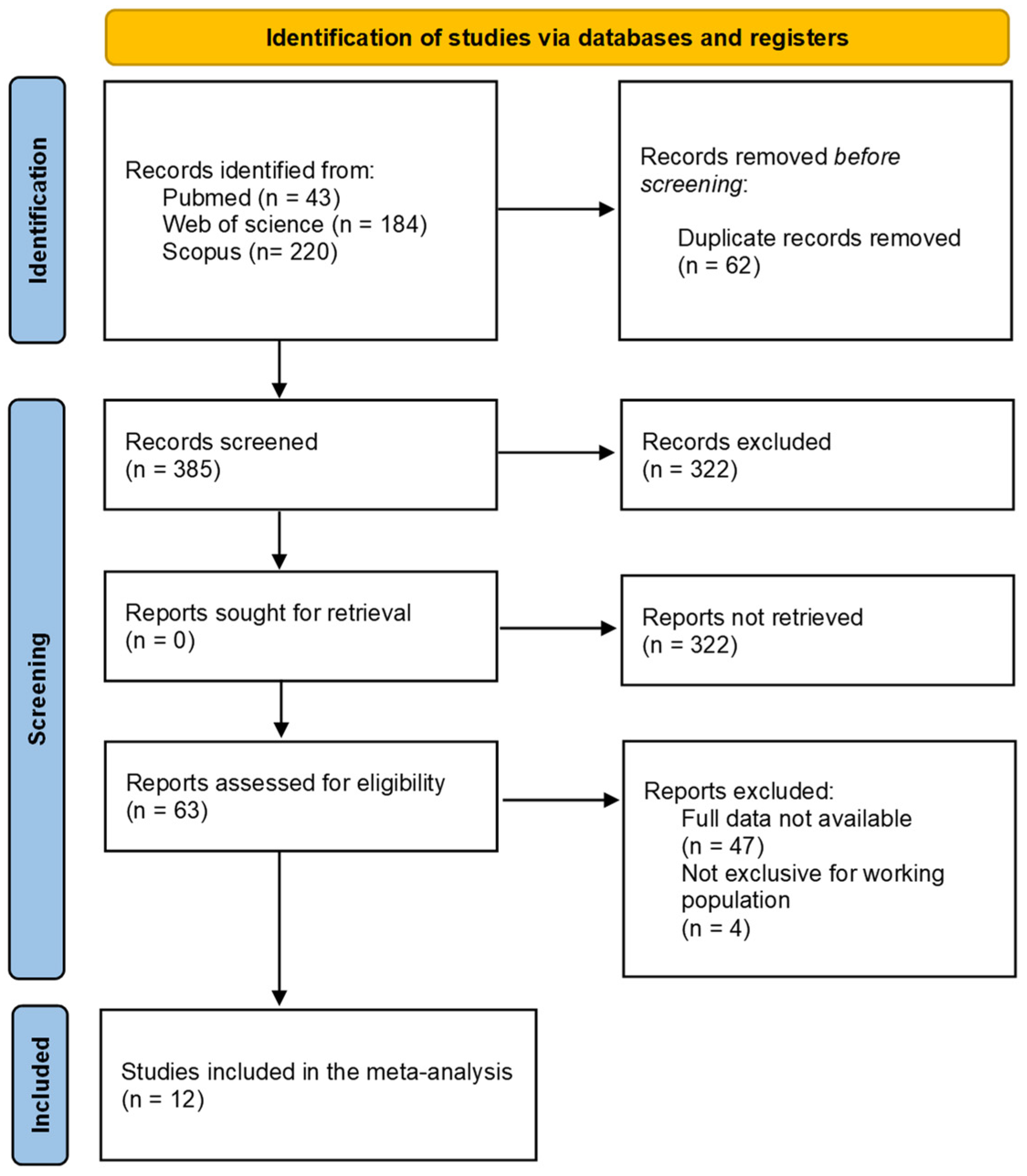
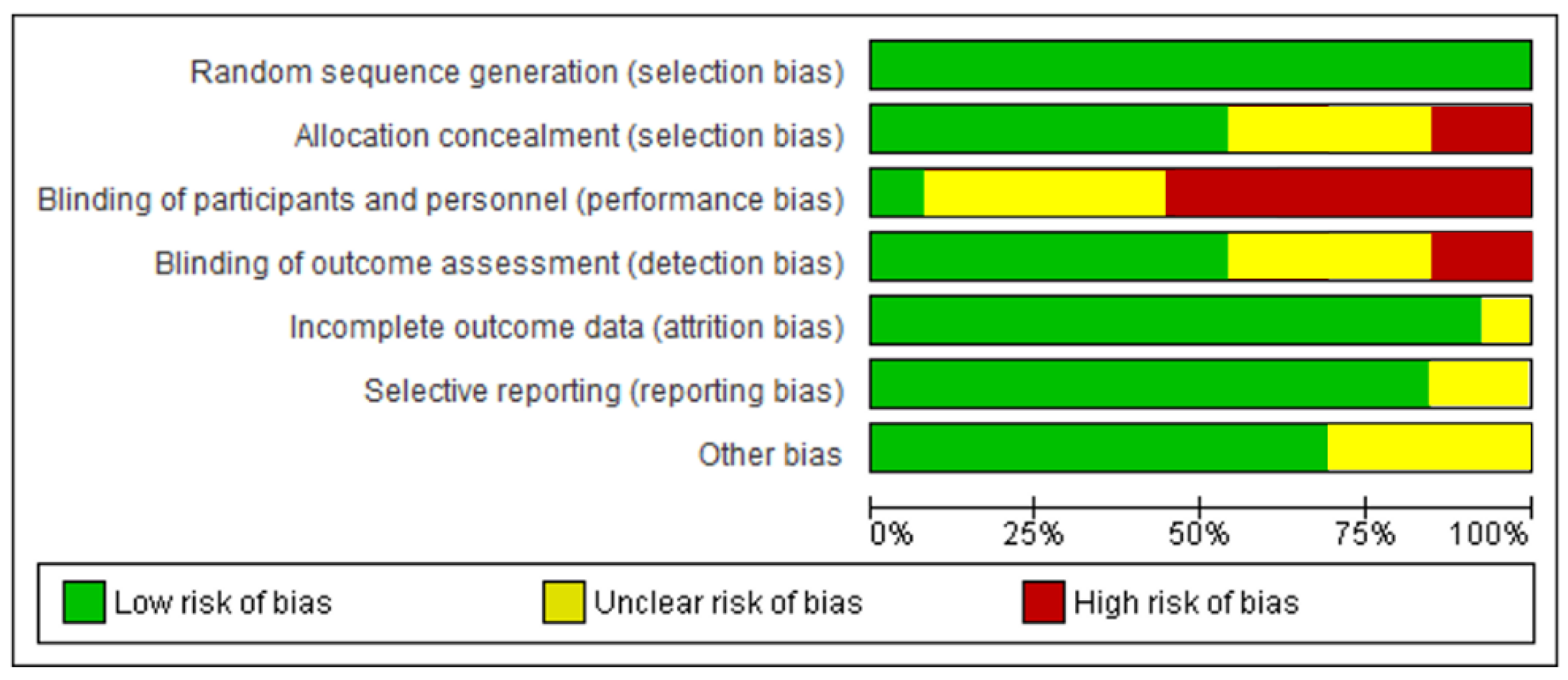

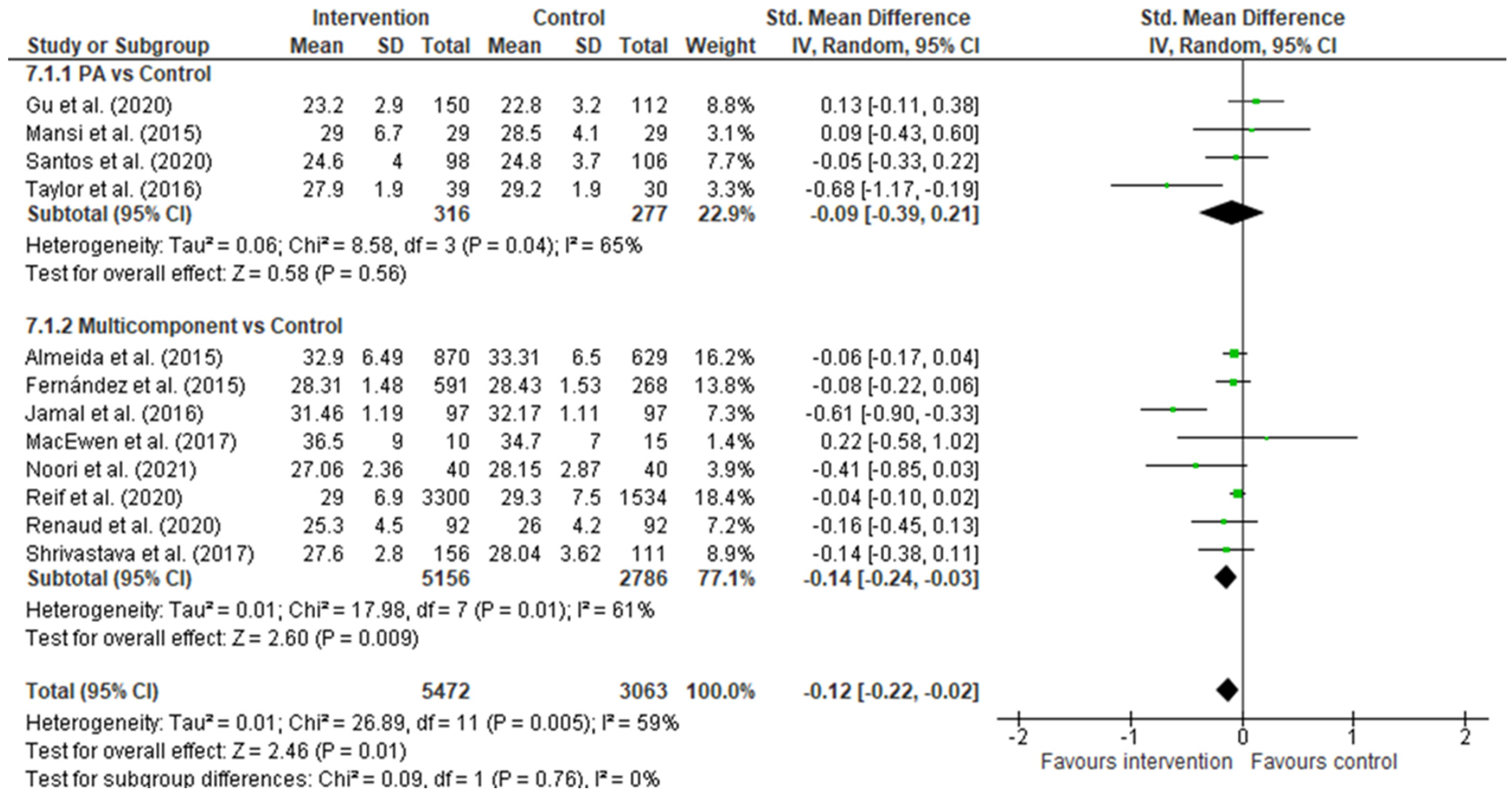
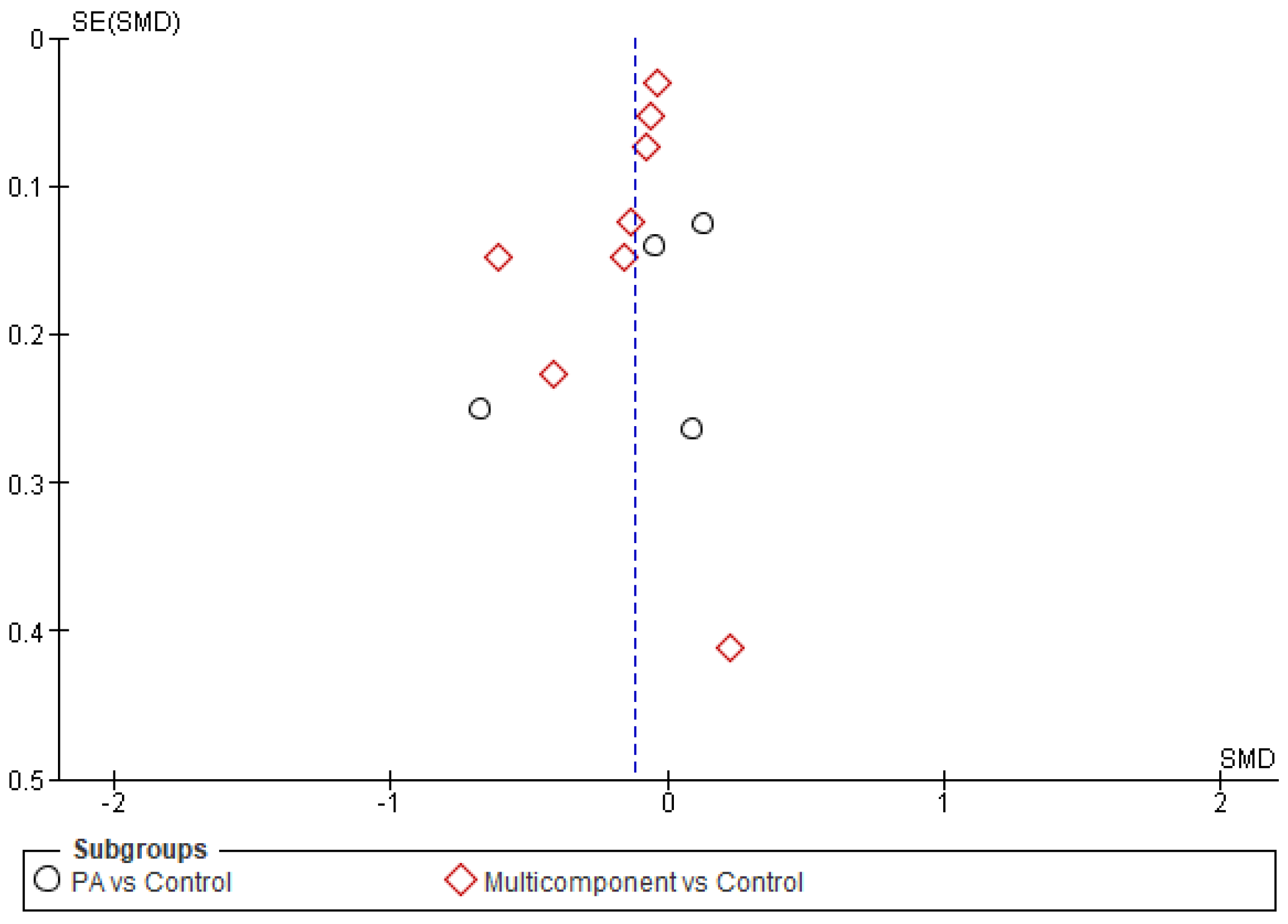
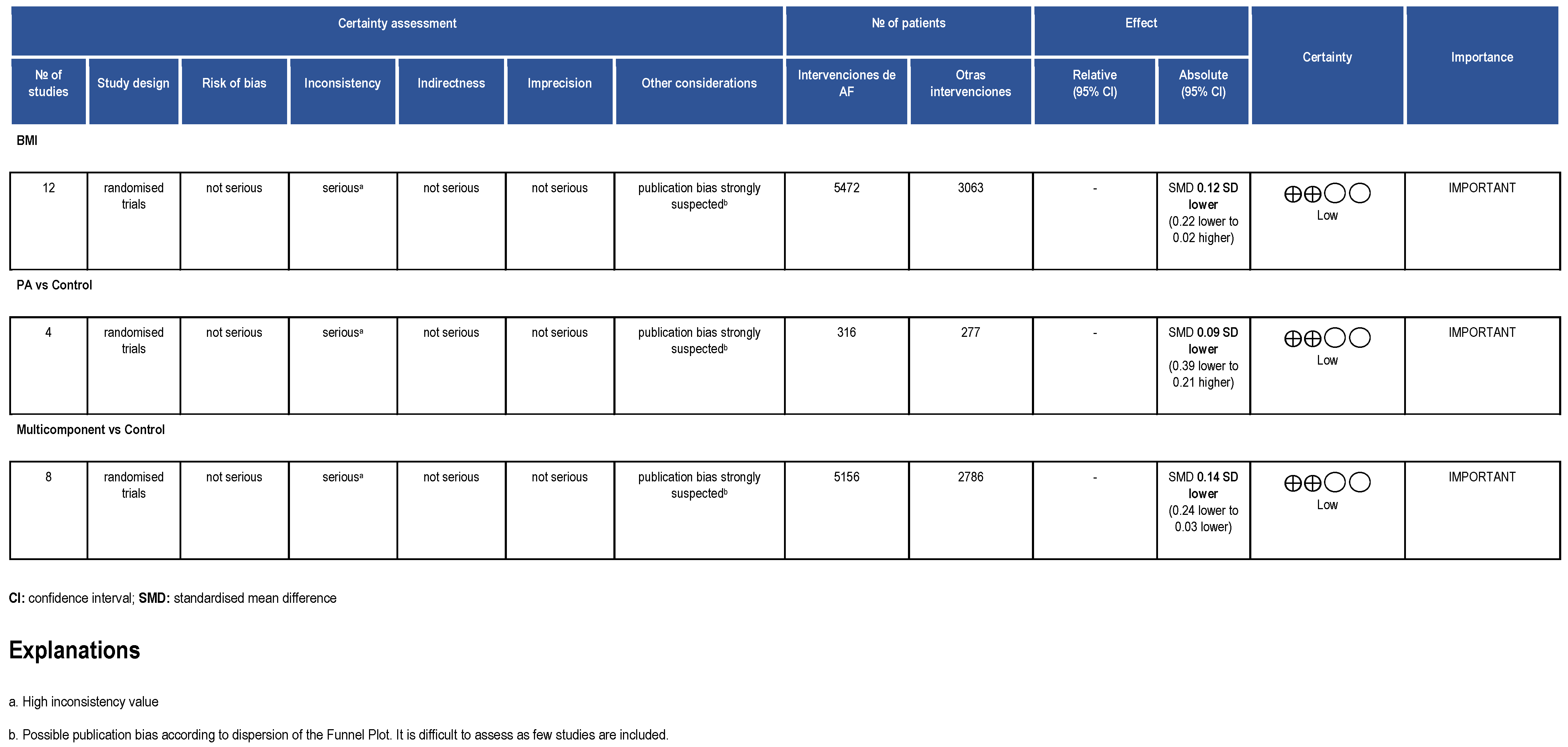
Disclaimer/Publisher’s Note: The statements, opinions and data contained in all publications are solely those of the individual author(s) and contributor(s) and not of MDPI and/or the editor(s). MDPI and/or the editor(s) disclaim responsibility for any injury to people or property resulting from any ideas, methods, instructions or products referred to in the content. |
© 2023 by the authors. Licensee MDPI, Basel, Switzerland. This article is an open access article distributed under the terms and conditions of the Creative Commons Attribution (CC BY) license (https://creativecommons.org/licenses/by/4.0/).
Share and Cite
Jiménez-Mérida, M.R.; Vaquero-Abellán, M.; Alcaide-Leyva, J.M.; Cantón-Habas, V.; Raya-Cano, E.; Romero-Saldaña, M. Effectiveness of Multicomponent Interventions and Physical Activity in the Workplace to Reduce Obesity: A Systematic Review and Meta-Analysis. Healthcare 2023, 11, 1160. https://doi.org/10.3390/healthcare11081160
Jiménez-Mérida MR, Vaquero-Abellán M, Alcaide-Leyva JM, Cantón-Habas V, Raya-Cano E, Romero-Saldaña M. Effectiveness of Multicomponent Interventions and Physical Activity in the Workplace to Reduce Obesity: A Systematic Review and Meta-Analysis. Healthcare. 2023; 11(8):1160. https://doi.org/10.3390/healthcare11081160
Chicago/Turabian StyleJiménez-Mérida, M. Rocío, Manuel Vaquero-Abellán, José M. Alcaide-Leyva, Vanesa Cantón-Habas, Elena Raya-Cano, and Manuel Romero-Saldaña. 2023. "Effectiveness of Multicomponent Interventions and Physical Activity in the Workplace to Reduce Obesity: A Systematic Review and Meta-Analysis" Healthcare 11, no. 8: 1160. https://doi.org/10.3390/healthcare11081160
APA StyleJiménez-Mérida, M. R., Vaquero-Abellán, M., Alcaide-Leyva, J. M., Cantón-Habas, V., Raya-Cano, E., & Romero-Saldaña, M. (2023). Effectiveness of Multicomponent Interventions and Physical Activity in the Workplace to Reduce Obesity: A Systematic Review and Meta-Analysis. Healthcare, 11(8), 1160. https://doi.org/10.3390/healthcare11081160






